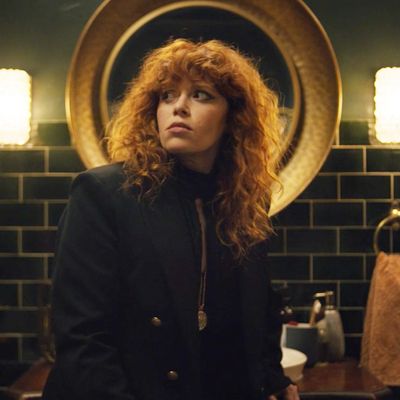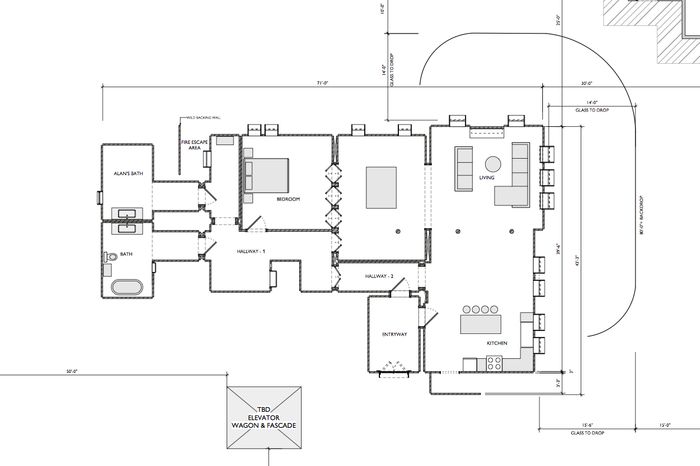
This post contains spoilers for the plot of Russian Doll.
If you’re going to have a character keep dying and waking up in the same place over and over again, you’re going to want to build a pretty interesting place for her to do it. That was the challenge Michael Bricker, the production designer for Netflix’s Russian Doll, faced in designing the bathroom Natasha Lyonne’s character Nadia finds herself returning to over the course of the series.
“We knew that this was her reset point, that it was going to continue to be important throughout the show” Bricker said, though he started on the design with only the first three episodes to use as a reference. Because the pilot includes mentions of Alice in Wonderland, he decided that the mirror Nadia faces would be round, like a portal to a different realm. In a similar vein, when she exits the bathroom each time, the room’s depth “could be viewed to increase over the course of the season, so that you just felt like you could get deeper and deeper and deeper in the rabbit hole.”
When she goes to leave the room, Nadia walks through a door with a gun-shaped handle and a mysterious blue galaxy-shaped light embedded within. “The description of the door was actually in the script,” Bricker said. “Then we puzzled through exactly how we were going to execute that and what it should feel like.” He described settling on a combination of “danger” and “playfulness” that resembles a kind of “galactic void.”
“It’s a pretty obvious metaphor for the show,” Bricker said, “but I think it really works, that the audience wants this door to mean something, and you can decide if it does or doesn’t.”
In the show, Nadia wakes up at her own birthday party, which is being held in the apartment belonging to her friend Maxine (Greta Lee) in a building that used to be a yeshiva. In the early episodes, she keeps dying while trying to leave the apartment, but as it progresses, she gets better at finding a way out, so Bricker designed the space to feel larger and smaller depending on Nadia’s perspective.
“In the beginning, she was making these really long walks through the apartment, hitting every room,” Bricker explained. “I like that you get to know the apartment, but it feels like it could be bigger or smaller. There’s another door around the corner, or there are more places that we didn’t get to see. There was definitely that intention, that there was always a space beyond the space that you’re in.” He compared the apartment’s layout to a series of concentric circles, mirroring the show’s title.
Russian Doll often references video games, given that Nadia is herself a game designer, and Bricker had fun pushing the show’s production design to wink at gamelike mechanics. As Nadia goes further away from the apartment and her reset point, the world around her gets less colorful. When Nadia meets Alan, who is also stuck in a time loop, his world is designed to look like the inverse of hers: “Where she’s dark, he’s light. Where she’s brown, he’s fair. Where she has tertiary colors, he has more primary colors.” Then, as Nadia and Alan’s lives bleed into each other, their worlds change. “His world becomes messier,” Bricker said. “Hers becomes a little bit cleaner.”
Around this time, viewers might also notice that other things start to disappear in their universes: animals vanish, plants wither, and eventually people start to go poof. “That was all totally mapped out, after the beginning,” Bricker said, noting that he pushed creator Leslye Headland and star Lyonne to have a consistent logic to the order of what disappears.
“The animals were the first to disappear, and plant life started to deteriorate, and the food, that was the next thing. And then onto the objects,” Bricker said, noting that they decided that organic things would be affected first but wanted to keep some of the logic a mystery. “It’s definitely difficult to map out while you’re shooting, but I think that we pulled it off, and it will be fun for the audience to discover.”



